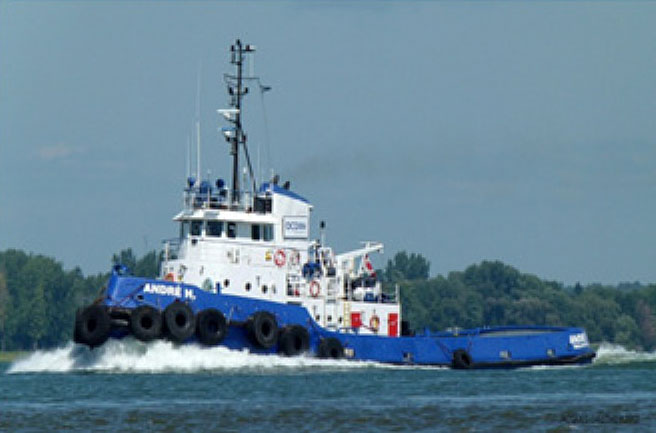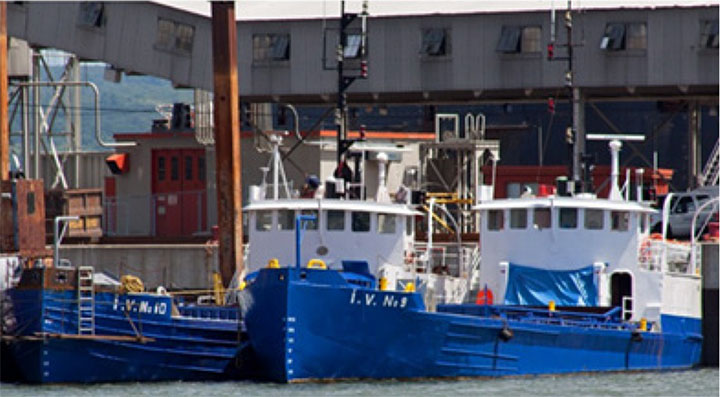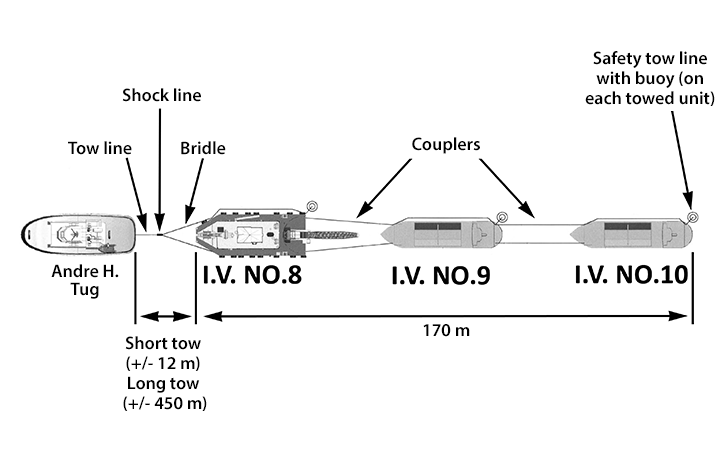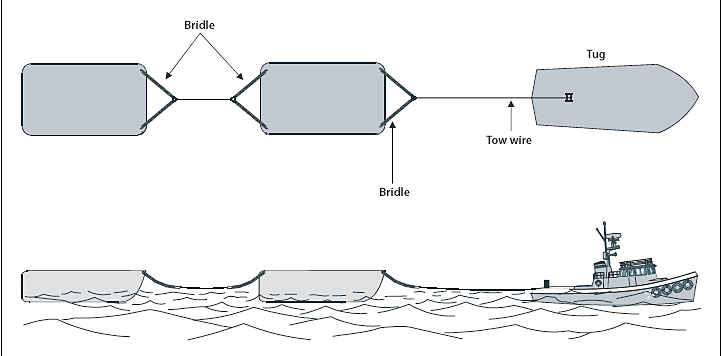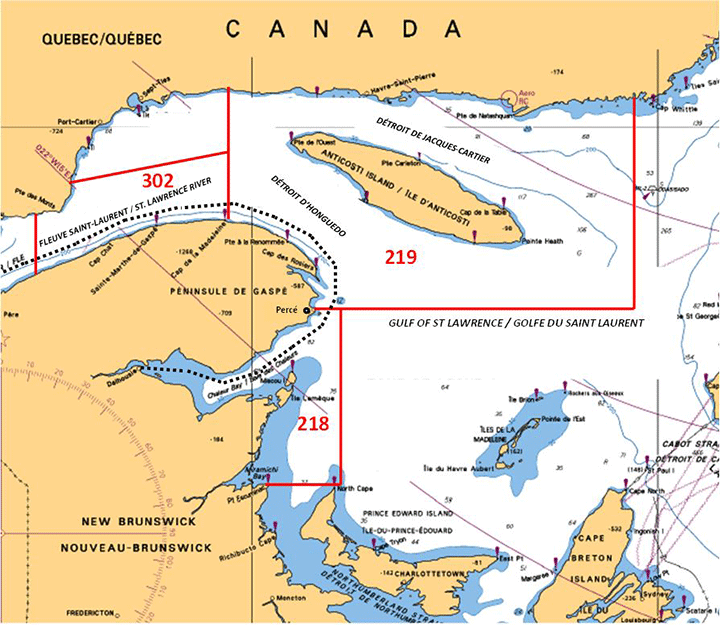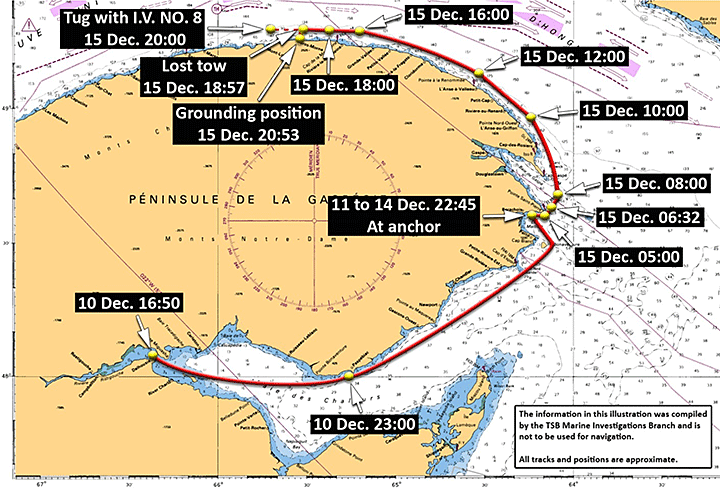Loss of tow and subsequent grounding
Tug Andre H. towing the barge I.V. NO. 8 and the vessels I.V. NO. 9 and I.V. NO. 10
Gros-Morne, Quebec
The Transportation Safety Board of Canada (TSB) investigated this occurrence for the purpose of advancing transportation safety. It is not the function of the Board to assign fault or determine civil or criminal liability. This report is not created for use in the context of legal, disciplinary or other proceedings. See Ownership and use of content. Masculine pronouns and position titles may be used to signify all genders to comply with the Canadian Transportation Accident Investigation and Safety Board Act (S.C. 1989, c. 3).
Summary
On 15 December 2013, at approximately 1830 Eastern Standard Time, the tug Andre H., while towing the service vessels I.V. NO. 8, I.V. NO. 9 and I.V. NO. 10, lost part of its tow in the Gulf of St. Lawrence, 2 nautical miles north of Gros-Morne, Quebec. The I.V. NO. 9 and I.V. NO. 10 broke free and later went aground near L'Anse Pleureuse, Quebec. No injuries or pollution were reported.
Factual information
Particulars of the vessels
| Name of vessel | Andre H. | I.V. NO. 8 | I.V. NO. 9 | I.V. NO. 10 |
|---|---|---|---|---|
| Official number | 318301 | 323025 | 158696 | 158687 |
| Port of registry | Trois-Rivières | Québec City | Québec City | Québec City |
| Flag | Canada | Canada | Canada | Canada |
| Type | Tug | Barge | Cargo | Cargo |
| Gross tonnage | 316.64 | 359.38 | 148.26 | 147.02 |
| LengthFootnote 1 | 35.81 m | 29.35 m | 32.55 m | 32.55 m |
| Draught at occurrence Forward: Aft: |
4.2 m 4.2 m |
1.52 m 1.82 m |
0.9 m 1.67 m |
0.9 m 1.67 m |
| Built/Rebuilt | 1963 | 1967 | 1936/1969 | 1936/1969 |
| Propulsion | 2 Fairbanks Morse diesel engines of 1234 kW driving 2 fixed-pitch propellers | Nil | 1 diesel engine of 170 kW driving 1 fixed-pitch propeller | 1 diesel engine of 170 kW driving 1 fixed-pitch propeller |
| Cargo | Nil | Dredging equipment | Nil | Nil |
| Crew | 7 | Nil | Nil | Nil |
| Registered owner | Océan Remorquage Trois-Rivières, Inc. | 8592802 Canada Inc. | Dragage Océan DSM, Inc. | Dragage Océan DSM, Inc. |
| Authorized representative | Océan Remorquage Trois-Rivières, Inc. | 8592802 Canada Inc. | Dragage Océan DSM, Inc. | Dragage Océan DSM, Inc. |
Description of the vessels
The Andre H. is a conventional tug of steel construction with 2 propellers and 2 rudders. The conning station, located in the wheelhouse above the deckhouse, is fitted with navigational equipment, including radars, a very high frequency (VHF) radiotelephone, a global positioning system (GPS), an automatic identification system (AIS), an electronic chart system, a NAVTEX (navigational telex) receiver, and an autopilot. The deckhouse includes a galley, storerooms, and accommodations. The towing winch and the towing hook are situated on the main deck aft of the deckhouse. The bollard pull has been measured at 19.7 metric tonnes.
The I.V. NO. 8 is a non-propelled barge of steel construction fitted with 3 spudsFootnote 2 and equipped with AIS. It is designed for dredging and equipped with a conventional crane that is fitted with a clamshell bucket. In addition, a deckhouse containing a workshop occupies most of the deck area. The crew accommodations and diesel alternators are situated in the barge's hold.
The I.V. NO. 9 and I.V. NO. 10 were self-propelled hopper dredge vessels equipped with AIS. The 2 vessels were used to dispose of dredged material, having an open-top cargo hold and hoppers in the bottom through which the cargo could be dumped. These 2 vessels were used as day boats and were fitted with basic crew accommodations and a wheelhouse, located aft.
History of the voyage
On 03 December 2013, in Québec City, Quebec, a crew boarded the Andre H. The next day, at 1700,Footnote 3 the tug proceeded downbound the St. Lawrence River, stopping in Rimouski, Quebec, to take under tow the vessels I.V. NO. 8, I.V. NO. 9 and I.V. NO. 10 that were required to complete a dredging contract in Dalhousie, New Brunswick. The 3 vessels were connected by the dredging crew in a tandemFootnote 4 tow configuration with polyolefin fibre rope couplers,Footnote 5 each approximately 37 m in length and 88 mm in diameter: the I.V. NO. 8 was followed by the I.V. NO. 9 and then the I.V. NO. 10 (Figure 1).
When the Andre H. arrived at Rimouski on 05 December, the tug's chief officer inspected the towing arrangement. The tug crew proceeded to hook up the tug's tow line, equipped with a steel cable bridle and a synthetic spring,Footnote 6 to the forward bitts of the I.V. NO. 8. The voyage resumed towards Dalhousie, and on 07 December at 0700, the tow reached Pointe Tracadigash, Carleton, Quebec, where the dredging crew embarked from shore onto the towed vessels to prepare them before arrival. The I.V. NO. 9 and I.V. NO. 10 were used, 1 on each side, to assist with the towing of the I.V. NO. 8. The tug and tow arrived in Dalhousie on 07 December at 0850. The dredging operations were then conducted up to 10 December.
At 1700 that day, the tug Andre H. left Dalhousie at a speed of 7 knots, towing the I.V. NO. 8, I.V. NO. 9, and I.V. NO. 10 towards Trois-Rivières, Quebec, in the same configuration as the previous voyage.
On the morning of 11 December, the Andre H. and its towed vessels encountered a westerly wind of 15 to 20 knots, snow flurries, and low visibility. Seeking shelter, the master turned the vessels around. At 1000, they arrived in the bay of La Malbaie near Percé, Quebec, and remained at anchor for 4 days, waiting for the weather to improve. During that time, the weather did not change and the AIS and navigation lights of the I.V. NO. 9 ceased to function, likely because the battery supplying the power for the AIS and the navigation lights had drained.
At 2245 on the night of 14 December, the tug heaved up anchor and proceeded towards Québec City at a speed of 6.4 knots. This speed would enable them to pass Pointe-des-Monts, Quebec, in the morning and avoid the strong northwesterly winds that were forecast for the area on the following Monday afternoon (16 December). Just after departure, the chief officer and deck crew lengthened the tow (but not to its maximum length), as requested by the master. After the work on deck was completed, the crew returned to the accommodations.
Since the tug was on a short tow, the chief officer did not declutch the winch nor apply the brake because he believed he would need to use the winch within a few minutes to lengthen the tow to its final length. This is the normal practice while operating the winch and adjusting the length of tow cable that is deployed, and conforms to the instructions posted on the winch panel. The brake is normally applied upon completion of the work and before the power pack is shut down. In this instance, the master informed the chief officer that the winch would be used to lengthen the tow in approximately an hour and a half, which was a longer delay than the chief officer had anticipated. Therefore, when the chief engineer requested to shut down the diesel hydraulic power pack, the chief officer agreed but did not go back outside to apply the brake before the power pack was shut down. The investigation could not determine why the chief officer did not apply the brake at that time.
The winch cable drum became declutched from the hydraulic motor, and the entire length of the tug towing cable unrolled itself from the towing winch and hung from the forward end of the I.V. NO. 8. The master stopped the tug, and the crew spent the next 7 hours, overnight, recovering the cable and rolling it back on the towing winch drum. On the morning of Sunday 15 December, the tug and tows departed to continue the voyage at an approximate speed of 7 knots along the coast of Gaspésie. At around 1830, as forecast in the Pointe-des-Monts sector, northeasterly winds reached 25 knots, waves were 2.5 m or more, there was reduced visibility due to snow, and freezing spray was accumulating on the starboard quarter of the tug. The master noticed that the AIS signal was showing that the I.V. NO. 10 was abnormally close to the I.V. NO. 8. Then, at 1847, the AIS position for the I.V. NO. 10 indicated it was slowing down and moving away from the towing arrangement. At this point, it was not possible to see if the I.V. NO. 9 was still in tow behind the I.V. NO. 8 because of poor visibility (snow flurries and darkness), the size of the accommodation block of the I.V. NO. 8, and the out-of-service AIS and navigation lights on the I.V. NO. 9. It was determined that the I.V. NO. 9 and I.V. NO. 10 were no longer under tow and were adrift.
After having contacted Marine Communications and Traffic Services (MCTS) at Les Escoumins, Quebec, and the company to advise them of the situation, the master continued the voyage without attempting to recover the lost service vessels. Another tug, the Ocean Arctique, was dispatched from Sept-Îles, Quebec, to try to recover the lost vessels, but the I.V. NO. 9 and I.V. NO. 10 went aground at L'Anse-Pleureuse after drifting for about 2 hours. The Ocean Arctique could not reach the vessels at their grounded positions, and returned to Sept-Îles.
The company advised the master on the Andre H. to tow the I.V. NO. 8 to Baie-Comeau, Quebec. Once this was completed, the Andre H. returned to L'Anse-Pleureuse, but was unable to recover the grounded service vessels. No further attempts were made due to the winter conditions, and the tug was subsequently laid up for the winter at the company's shipyard.
Damage to the vessels
The I.V. NO. 9 and I.V. NO. 10 were declared total constructive losses and were dismantled on site.
Environmental conditions
The environmental conditions varied significantly during the voyage. At the time that the master became aware of the partial loss of the tow, the winds were from the northeast at 25 knots, with waves of 2.5 m or more and freezing spray. Visibility was reduced due to snow.
Forecast information
On Saturday 14 December, at 2000, Environment Canada issued the following forecast for the sector of Anticosti (Appendix A), which was available by VHF radio via MCTS and through the tug's NAVTEX receiver:
Gale warning in effect. Freezing spray warning in effect. Wind northwest 25 to 35 knots except northwest 40 in the Honguedo Straight. Wind becoming northwest 20 to 30 near midnight then diminishing to northwest 15 to 20 late overnight. Wind diminishing to light early Sunday morning then increasing to east 15 to 20 Sunday afternoon. Wind increasing to northeast 30 to 40 Sunday evening. (…)
On Sunday 15 December, at 0300, the marine forecast for the sector of Anticosti was the following:
Gale warning in effect. Freezing spray warning in effect. Wind northwest 20 knots diminishing to light early this morning then increasing to east 15 to 20 this afternoon. Wind increasing to northeast 35 this evening then diminishing to northeast 25 Monday morning. Wind backing to northwest 25 Monday evening. Flurries ending early this morning. Snow beginning this afternoon and changing to chance of flurries Monday evening. Visibility 1 mile or less in precipitation. (…)
At the same time on 15 December, the forecast for the sector of Pointe-des-Monts to the southern half of Anticosti was the following:
Gale warning in effect. Freezing spray warning in effect. Wind westerly 10 to 15 knots diminishing to light early this morning. Then increasing to east 15 late this morning. Wind increasing to Easterly 25 to 35 this afternoon then becoming northeast 25 overnight. Wind backing to northwest 20 Monday afternoon. Snow beginning near noon. Visibility 1 mile or less in snow. Freezing Spray beginning this afternoon. Temperatures minus 16 rising to minus 7 this evening.
Vessel certification
On 10 May 2013, Transport Canada (TC) issued an inspection certificate to the Andre H., valid for near coastal voyage, Class 1. The tug also held a valid Radio inspection certificate, and 5 Minimum Safe Manning documents.
The I.V. NO. 8 is an unmanned barge and is not required to be inspected or certificated by Transport Canada Marine Safety and Security (TCMSS).
On 04 June 2013, TC issued an inspection certificate to the I.V. NO. 9 and the I.V. NO. 10 valid for near coastal voyage, Class 2, home-trade voyage, Class III.
Personnel certification and experience
The master, officers and crew were properly certified for their positions on board. The master had acted as master on various tugs since 2008. The chief officer had sailed as officer on variety of vessels, including tugs, since 2003.
Company information
OcéanFootnote 7 constitutes a group of companies operating in many spheres of marine activity: harbour towing, pilot boat services, salvage, dredging, transportation, shipbuilding and repairs. The group employs approximately 700 persons and operates in the Great Lakes Basin, St. Lawrence River and Gulf, and the Maritimes. It also performs dredging operations in the Dominican Republic and Mexico.
When the dredging division requests a tug to transport equipment between locations where dredging has to be performed, the managing director of harbour towing operations analyzes elements such as the available resources, suitability of the tug for the intended job, etc. Once a particular tug is designated, the managing director, in consultation with the dredging project manager, assigns crews for its operation. The assigned dredging project manager, using charts and pictures, indicates to the master where to dock.
This particular contract at Dalhousie was a touch-up of a contract previously carried out in the Dalhousie harbour. No particular voyage planning was conducted.Footnote 8 The dredging equipment had been towed previously and the towing arrangement was always the same: the I.V. NO. 8 was in first position with the generator running to supply power for the navigation lights, followed by the I.V. NO. 9, with its navigation equipment and lights powered by a battery, and the I.V. NO. 10 with its navigation equipment and lights powered by a battery that was recharged by a solar panel.
Towing arrangement
The 3 service vessels were connected in a tandem tow configuration with polyolefin fibre rope couplers (2 per tow). Each coupler was approximately 37 m in length and 88 mm in diameter. In the arrangement, the I.V. NO. 8 was followed by the I.V. NO. 9 and the I.V. NO. 10. The Andre H. tow line was a wire cable of approximately 455 m in length and was equipped with a steel cable bridle and a synthetic spring. It was attached to the towing winch at the bitter end,Footnote 9 so that it would be easily disconnected by the momentum of the wire if it were to detach from the drum.
In 2012, the dredging project manager had arranged for 4 rope couplers of 37 m each, for the towing of the I.V. NO. 9 and I.V. NO. 10. They had been used once in the summer of 2012 and on 4 other occasions before the occurrence. Different tugs owned by the company were used to tow the ensemble between ports. When the barges were required to transit, the dredging crew arranged the 3 vessels in a tandem configuration and installed the couplers between the 3 vessels. The couplers were visually verified by the chief officer of the tug in use, then a tow line was attached between the tug and the I.V. NO. 8, and the tug towed the 3 service vessels.
At the time of the occurrence, it was common practice for the company to use rope couplers in a tandem configuration for the towing of this equipment. Rope couplers are relatively light and easy to manoeuvre and store. They were used by the crew a few times every season and are suitable for a multiple tow in tandem in a channel or otherwise sheltered and restricted waters, when good control of the tow is required. The couplers were visually inspected by the dredging crew before and after each use. Two couplers were stored on the I.V. NO. 9 and on the I.V. NO. 10 in dry locations protected from the sun.
The 2 couplers used between the I.V. NO. 8 and the I.V. NO. 9 were pulled out of the water by the tug crew upon arrival in Baie-Comeau and stored on the deck of the I.V. NO. 8. They were later recovered by the TSB investigator on 13 February 2014 and sent to the TSB Laboratory for examination and testing. Tests demonstrated that the strength of both fibre ropes had degraded substantially: they had a residual resistance of 57% and 66% of their original breaking strength. It was determined that abrasion and, in the case of 1 of the ropes, contamination of the outer strands by oil and sand, were contributory to the observed loss of breaking strength. Furthermore, both ropes exhibited a lighter colour on the outer surfaces of the blue strands: such discolouration is consistent with degradation due to exposure to ultraviolet (UV) radiation from sunlight and this was also found to be contributory to the loss of breaking strength. The 2 couplers between the I.V. NO. 9 and the I.V. NO. 10 were not recovered until the spring by Océan personnel, and were subsequently given to the TSB for testing. These couplers were found to be too damaged by their long immersion in water and ice to be tested.Footnote 10
Industry standards for towing
To ensure safe passage, the gear used to connect a tug with its tow needs to be strong, yet flexible enough to withstand the forces likely to be encountered during a voyage. Numerous industry standards provide guidance on best practices for towing, the adequacy of the elements used in a tow, and how to best arrange those elements.Footnote 11
According to these standards, in exposed waters, a long all-wire towing arrangement is preferred. The accepted way to connect multiple tows is for intermediate tow lines to connect the following tow to the stern of the one forward with bridles. Moreover, in order to minimize the surging action between the towed vessels, the tow lines must be of an appropriate length to allow for an adequate catenary effect (Figure 2). Multiple tow lines from the tug may also be used to achieve the same effect (Figure 3).
The catenary effect of the curve of a towing wire, cable or chain of a certain length increases the ability of the tow to absorb the shocks caused by severe environmental conditions by acting as a kind of spring that relieves peak dynamic tensions.Footnote 14 Synthetic fibre rope couplers have no catenary effect, as they are short and float on the water.
Towing winch
The towing winch on board the Andre H. is a single drum winch, hydraulically operated and equipped with an automatic spooling device and a friction band brake that is operated manually or by air pressure. The winch is also fitted with an air-operated emergency release cylinder that is activated by either of the 2 tow-abort buttons. The buttons are located at 2 control stations: 1 station is on the stern main deck on the starboard side of the winch, while the other is in the wheelhouse. The 2 stations are interlocked, such that when one is in use, the other is disabled. The tow-abort buttons are always operational.
The hydraulic pressure is supplied by a diesel-engine-driven hydraulic power pack located in the engine room. The diesel engine is started and stopped manually by the engineer of the watch when there is a need for the tow line or to adjust the length of the tow. During regular tow operations, once the tow line length is adjusted, the diesel hydraulic power pack is no longer needed and is shutdown. The winch drum is then held in place by the brake. The towing winch and brake were tested by the TSB, post-occurrence, and found to be in good operating condition.
Transport Canada oversight of towing
TC does not monitor all towing operations prior to departure. However, operators must develop appropriate procedures for the safe operation of the vessel, means to deal with emergencies, and means to ensure that the crew receives safety training in order to meet their obligations under the Canada Shipping Act, 2001.Footnote 15 In the case of towing operations, these procedures should also take into account available industry guidelines for best practices.Footnote 16 Authorized representatives and recognized organizations can consult the Guidelines for the Construction, Inspection, Certification, and Operation of Tugs of less than 24 Metres in Length (TP 15180 E). Regulations pursuant to the Canada Shipping Act, 2001 and TC's Notices to Inspectors both require that a TCMSS inspector verify the function of the tow-abort equipment and that the tug is fitted with means to communicate with the tow winch stations. These 2 items were verified at the last vessel inspection by a TCMSS inspector. In this occurrence, neither the master nor the company had the towing arrangement inspected by a third-party organization or a regulatory body (e.g. classification society). Furthermore, there are no regulatory requirements to have TC inspect the towing arrangement.
Navigation lights and shapes
The International Regulations for Preventing Collisions at Sea (COLREGS) are an international convention that establishes, among other things, the rules of conduct at sea when a risk of collision exists between vessels. The Collision Regulations require vessels to exhibit the prescribed navigation lights (from sunset to sunrise) and shapes (by day). These serve not only to identify the vessel and its type, but the operation that it is engaged in or its situation. Furthermore, the regulations define responsibilities between vessels and include requirements to avoid another vessel, depending on the respective type, operation or situation of each vessel.
The Collision Regulations state that a towing vessel shall exhibit 2 masthead lights in a vertical line.Footnote 17 When the length of the tow exceeds 200 m, 3 masthead lights in a vertical line shall be exhibited. In addition, a towing vessel must exhibit sidelights, a sternlight, a towing light in a vertical line above the sternlight, and a diamond shape where it is most visible. Vessels being towed are required to exhibit sidelights, a sternlight, and when the length of the tow exceeds 200 m, also a diamond shape where it can best be seen.Footnote 18
In this occurrence, the length of the tow was greater than 200 m. The Andre H. was not exhibiting a diamond shape. The I.V. NO. 8 was not exhibiting a sternlight, and the diamond shape was being exhibited in conjunction with the shapes for a vessel not under command and those prescribed for a dredging vessel when an obstruction exists. The I.V. NO. 9 was not exhibiting a sternlight or diamond shape. The I.V. NO. 10 was not exhibiting a diamond shape.
Previous occurrences
Towing arrangement
In November 2004, the tug Manson, with a crew of 2, was towing the crane barge McKenzie and the deck barge M.B.D. 32.Footnote 19 During the transit through the Strait of Georgia, British Columbia, the couplers connecting the M.B.D. 32 to the stern of the McKenzie parted, and the Manson was unable to recover the M.B.D. 32. The TSB investigation found that the towing arrangement was inadequate: the use of shorter, synthetic rope couplers instead of a longer, all-wire arrangement, while towing in open waters, resulted in the parting of the couplers.
The TSB recorded an occurrence involving the tug Henry Christoffersen, where the couplers broke in poor weather conditions and the towed vessels were lost and went aground.Footnote 20
In January 2013, the tug Charlene Hunt lost its tow off Cape Race, Newfoundland and Labrador, when the towing arrangement failed in heavy weather.Footnote 21 The TSB investigation found that available guidelines respecting the design and construction of towing arrangements were not followed. Furthermore, the towing arrangement was inadequate for the intended voyage, and the relief master did not adequately prepare to compensate for the environmental conditions that were encountered.
In that investigation, the TSB also found that TC had developed a draft policy on the inspections of tugs and tows bound for international voyages out of Canada. The policy provides TCMSS inspectors with a framework to assess the tugs and tows, and specifies that TC would assess each towing operation to ensure compliance with sections 111 and 189 of the Canada Shipping Act, 2001.
Navigation lights and shapes
During the night of 07 August 1999, the tug Jose Narvaez was towing the coal-laden barge Texada B.C. on a 274-m-long cable tow line.Footnote 22 The operator of the pleasure craft Sunboy mistakenly passed between the tug and the barge, and, when the propellers of the Sunboy became entangled in the tow line, the pleasure craft was struck by the oncoming barge and capsized. There were 4 fatalities, with an additional person missing and presumed drowned. The TSB investigation found that the absence of an effective sidelight on the Texada B.C. with a visible range of 3 nautical miles (nm) deprived the operator of the Sunboy of a vital collision-avoidance cue as to the presence and location of the barge.
TSB Laboratory reports
The following TSB Laboratory report was completed:
- LP 57/2014 – Tow Rope Failures
Analysis
Events leading to the loss of the tow and grounding
After leaving the anchorage in the bay of La Malbaie, Quebec, on the night of 14 December, the Andre H. and the 3 vessels it towed had about 160 nautical miles (nm) to sail before they would reach a position that the master estimated would offer some protection from the northwesterly winds that were forecast for the afternoon of 16 December. This distance could be traversed in about 24 hours in favourable weather conditions if they sailed at a speed of approximately 6.5 knots.
The northwest winds were a concern as, previously during the voyage, the tug and its tow had to seek refuge from a northwest wind that acted on the port side of the tow. Although there were strong northeasterly winds forecast for the Pointe-des-Monts to the southern half of Anticosti area, the master evaluated that they did not pose a risk as the wind would be coming from the stern of the tow. As such, his intent was to pass Pointe-des-Monts, where the tow would be protected by the land, before the winds turned to the northwest, on the following afternoon. Although there was a delay of 7 hours, caused by the unrolling of the towing cable from the winch drum, the tug and tow would still have sufficient time, approximately 29 hours, to pass Pointe-des-Monts. Therefore, the master decided to continue the voyage following the delay.
By approximately 1830 on 15 December, the tug and towed vessels encountered the forecast northeasterly winds of 25 knots, which acted on the vessels' stern/starboard quarters and caused waves of 2.5 m or more. Due to the combined forces of the tow, waves, movements of the vessels, and the degraded condition of the synthetic rope couplers, the couplers parted and the I.V. NO. 9 and I.V. NO. 10 drifted away from the rest of the tow. Two hours later, the service vessels went aground on the nearby shore.
It was considered too dangerous to recover the 2 service vessels after they drifted away. They were only 2 nm from land with onshore winds of 25 knots. Other inhibiting factors included freezing spray and reduced visibility due to the snow and darkness. The Andre H. was the only tug on the scene, with a limited crew to carry out the recovery, and the I.V. NO. 8 was still under tow.
Design and inspection of the towing arrangement
As control over the tow is paramount when towing in sheltered waters, such as a harbour or a river, it is common practice to use synthetic rope couplers for towing operations. However, in exposed waters where changing wave height and frequency is likely to place a greater stress on the towing equipment and possibly lead to the loss of towed vessels, it is essential that the towing gear, including the couplers, be robust and long enough to absorb shock.
In this occurrence, contrary to accepted industry standards for towing, the towing arrangement employed synthetic fibre rope couplers, despite the exposed waters in the area, time of year, and expected weather conditions.
In exposed waters, industry standards prescribe the use of a long all-wire towing arrangement, where the steel cables allow for a catenary effect to absorb the shock from the sea movement and traction of the tug. Synthetic ropes offer no catenary effect and do not dampen the movement of the tow, as the ropes float and are relatively short. In addition, TSB Laboratory analysis determined that the recovered rope couplers that were in use had reduced breaking strength, likely caused by abrasion, contamination, and exposure to sunlight. Thus, the rope couplers were unable to withstand the forces created by the tow and movement of the waves, which caused them to part.
The towing arrangement used on the Andre H. was determined by the dredging manager, without reference to industry standards. Although the arrangement may have been adequate for navigating in sheltered waters, there was no consideration given, prior to commencing the voyage, to changing the towing arrangement based on the environmental conditions and sea states that the vessels could encounter. There were also no company procedures requiring this to be done.
Furthermore, despite the arrangement having been inspected by the tug's chief officer before departure from Rimouski, Quebec, the degraded condition of the rope couplers was not identified, nor did the crew have any standard against which to assess the condition of the towing equipment.
If towing vessel operators do not have procedures and do not adopt standards to ensure the adequacy of their towing arrangement and the condition of their towing equipment, there is an increased risk of failure of the towing equipment and loss of tow.
Navigation lights and shapes
The International Regulations for Preventing Collisions at Sea (COLREGS) require vessels to exhibit specific lighting arrangements or shapes for detection and identification purposes. Furthermore, the Collision Regulations establish responsibilities as to which vessel is required to take action to avoid collision. Only the prescribed lights and shapes are to be exhibited in order to avoid confusion.
In this occurrence, the tug and towed vessels did not exhibit the required lights and shapes, and no assessment was conducted as to their compliance with the Collision Regulations. There were no company procedures to ensure that masters were exhibiting the appropriate lights and shapes on their vessels.
Furthermore, on the I.V. NO. 8, the dredging and not-under-command shapes were being exhibited in addition to those required for a vessel under tow. This arrangement is visually confusing and may prevent proper identification of the tow and type of operation. A TSB investigation previously found that the absence of an effective sidelight on a barge being towed, a vital collision-avoidance cue, prevented the operator of another vessel from detecting the presence of a barge (TSB Marine Investigation Report M99W0133).
If towing vessel operators and masters do not ensure that the prescribed navigation lights and shapes are exhibited, a vessel may not be detected, or the correct actions for collision avoidance may not be taken, increasing the risk of collision.
Findings
Findings as to causes and contributing factors
- The master underestimated the risk posed by the northeasterly winds forecast for the area and chose to continue the voyage after the delay caused by the unrolling of the towing cable.
- The towing arrangement was inadequate for the environmental and operational conditions. The synthetic rope couplers employed in the towing arrangement were in a degraded condition and they parted during the voyage, and the service vessels I.V. NO. 9 and I.V. NO. 10 drifted away from the tow.
- The crew of the Andre H. was unable to recover the service vessels that broke free, and the vessels went aground on the nearby shore.
Findings as to risk
- If towing vessel operators do not have procedures and do not adopt standards to ensure the adequacy of their towing arrangement and the condition of their towing equipment, there is an increased risk of failure of the towing equipment and loss of tow.
- If towing vessel operators and masters do not ensure that the prescribed navigation lights and shapes are exhibited, a vessel may not be detected, or the correct actions for collision avoidance may not be taken, increasing the risk of collision.
This report concludes the Transportation Safety Board's investigation into this occurrence. The Board authorized the release of this report on . It was officially released on .
Appendices
Appendix A – Sectors corresponding to weather forecasts
- ---
- Intended route
- 218
- Chaleur – Miscou
- 219
- Anticosti
- 302
- Pointe-des-Monts to Anticosti – Southern half
